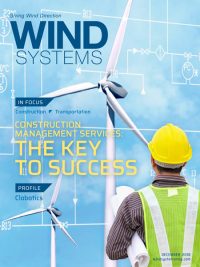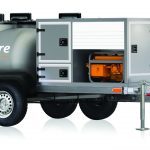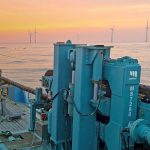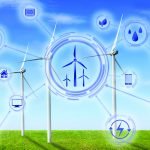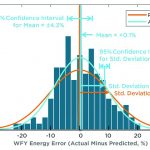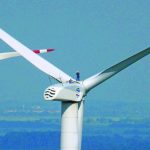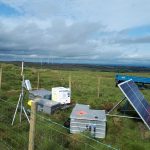Slowly but surely, the floating offshore wind-energy sector is becoming more important, particularly because of the fact that the number of locations with shallow waters suitable for fixed-bottom foundations is limited. Floating wind is turning into a highly scalable future energy source because the wind resource in deep waters is extensive and offers a significant potential for marine renewable energy development and growth to many countries.
Europe remains the world leader in floating wind-energy installations with the North Sea being the main region for deployment, accounting for 78 percent of the European total, followed by the Baltic Sea, with 14.1 percent. Based on the number of offshore wind projects under construction, WindEurope estimates total European offshore wind capacity will be 24.6 GW by 2020.
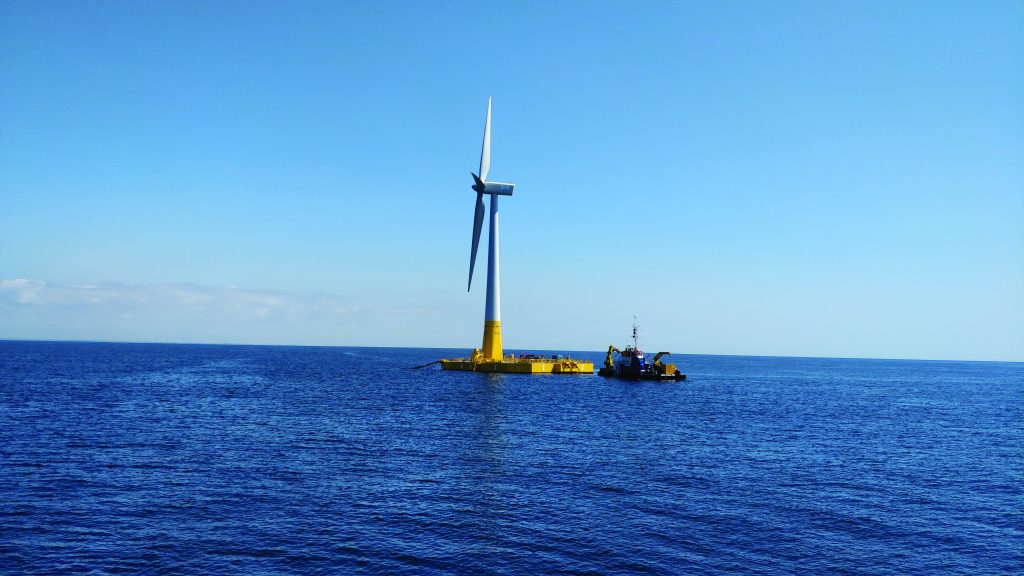
Furthermore, Europe is continuously investing in innovative projects and designs aimed at improving the performance, maintenance, and installation of offshore floating wind turbines.
There is Hywind and the simulations models developed by Nielson [1] for integrated dynamic analysis and the role of the effect of pitch-angle control of blades. There is other research done as well into the pontoon-type floating wind turbine [2], aimed at characterizing the dynamic response and at identifying potential loads and instabilities, resulting in significant design modifications.
It is important to mention that, besides leading European industries, there are a couple of serious emerging markets interested in the development and deployment of offshore floating wind power. Between 2017 and 2026, China is expected to install 13 GW (a big part of it in floating solutions), according to the MAKE magazine. The Global Offshore Wind Market Report (Norwegian Energy Partners) points out the capacity of China, Japan, and Taiwan to become global market leaders after 2020.
Latest researches from Equinor emphasize the fact that in the U.S. and Japan, there are only a few sites suitable for bottom-fixed installations since fixed-based wind is not viable in water depths of 60 meters or more. Therefore, floating turbines could be a game changer in these areas by overcoming the engineering challenges of deep-water installations and yield that untapped potential.
The Sector’s Biggest Challenges
Even though progress is clear, all professionals know the industry is still facing significant challenges with the need for appropriate vessels for installation and maintenance, innovative design solutions, and the lack of industry standardization. Weather fluctuations are another significant hurdle, and to fight these, offshore wind installations still need improvement in installation vessels — better navigation, higher crane capacity, and more space.
Since the floating offshore wind turbine is a relatively recent invention, there is still a lot of room for new ideas concerning the way the turbine can be held in place and the entire design of the configuration. Mooring architecture, which has been successful in the oil and gas industry, includes the catenary mooring or the taunt leg. For the platform, the assessment is the same with the development of semi-submersible or spar platforms, which are well known in the offshore industries. These solutions aren’t perfect, and their choice strictly depends on the project’s priorities, including environmental conditions and operating parameters.
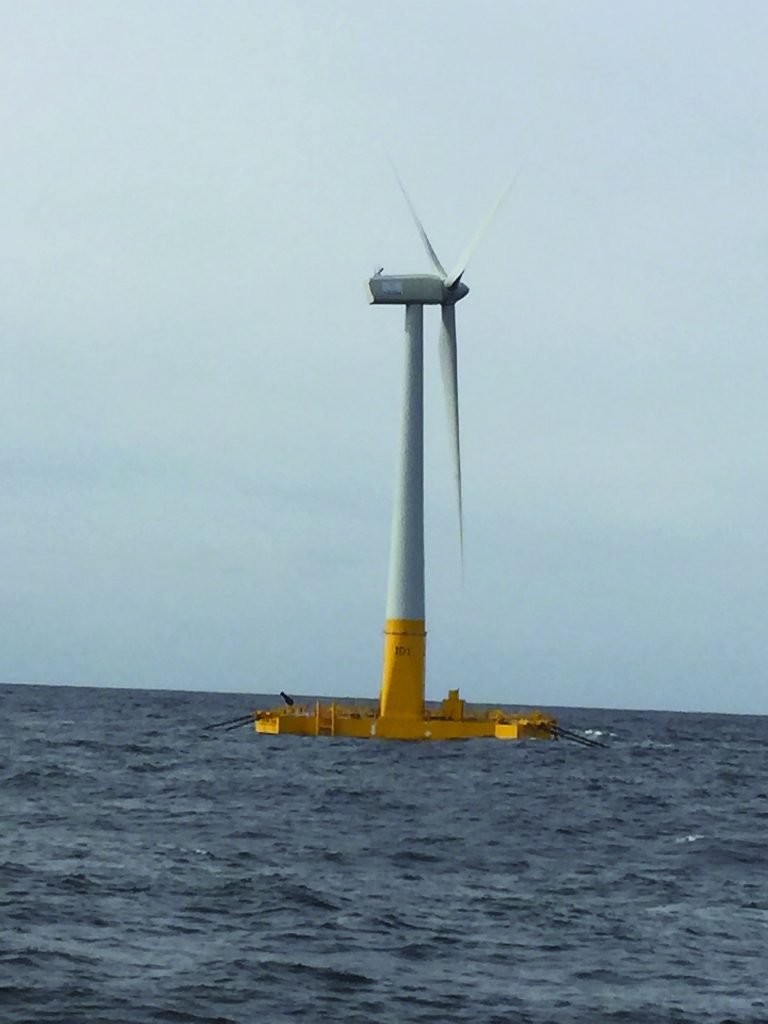
Another problem originates from the power grid connection. Integrating large amounts of offshore wind generation to the power system requires solid knowledge and better infrastructure.
Technical advancements
Areas where the most progress was achieved include larger, more effective turbines and improved foundations.
Here are some examples:
• Equinor (Ex Statoil) deployed the first full scale spar buoy off Karmoy Island in 2009. The 5,300 metric ton spar buoy was equipped with a 2.3 MW wind turbine. In 2017, Equinor deployed Hywind Scotland, the first floating pilot wind farm. This project features an important scaling with an 11,200 metric ton spar buoy and five 6-MW wind turbines.
• Ideol deployed earlier this year a prototype based on its damping pool platform, a platform different from all known oil and gas standards such as spar, semi sub, or TLP. Moreover, its mooring system is equipped with innovative synthetic fiber mooring lines, an innovative choice of material for a permanent mooring system.
• At an earlier stage of deployment, Sway has chosen the horizontal axis for its wind turbine. This technological choice, according to Sway, lowers the center of gravity, eases the maintenance, and reduces the spacing between wind turbines.
• Still in a concept phase, Hexicon expects to reduce CAPEX and installation costs by developing floating multi-turbine platforms allowing the increase of power generated per platform.
There are, of course, some hybrid types comprising two or three of the mentioned turbines — for example, the spar floater and tension leg mooring system mix. However, much more advancement is expected in this area.
Despite the different types and configurations, there are, in general, three basic floater types of floating offshore wind turbines:
• The semi-submersible type, moored by catenary lines.
• The TLP (Tension Leg Platform) type, moored by vertical tendons, using buoyancy.
• The spar type, formed as a single deep-draft cylindrical and vertical column.
The biggest challenge concerning the foundation type is cost can quickly increase, and therefore the demand for innovative, cost-efficient, and high-quality solutions is needed. Mooring methods feature a close relationship with the construction performance, and for a successful turbine, performance should be carefully studied. Many tests and observations have confirmed that the mooring method using weights is highly effective in reducing cost.
In general, a floating platform can achieve stability through ballast, mooring lines, and buoyancy. It is important to mention the performance of the turbine is affected by the choice of platform, and every existing concept uses one or a combination of these three primary stability methods.
Clump Weights
Floatgen is the first French floating offshore wind turbine system for power generation in Atlantic waters. The three main objectives of this project are to prove the technical, economic, and environmental feasibility of an EU technology floating system in deep waters, bringing wind-energy applications closer to market in diverse European deep offshore areas, and assessing the expected global generation cost per MWh in a 15-year perspective.
The turbine was submerged in September 22 kilometers off Le Croisic (Loire-Atlantique) and is expected to provide electricity to the 5,000 residents of the city.
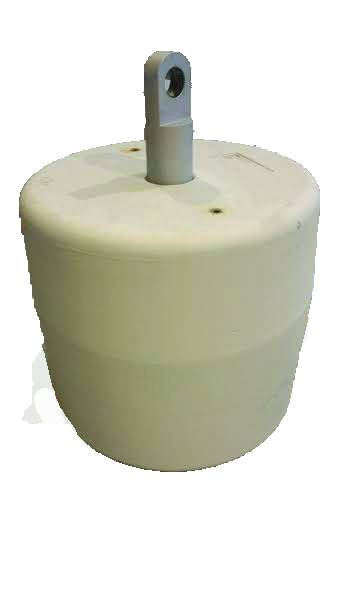
Floatgen is kept in place by a mooring design using clump weights designed and manufactured by the European leader in ballast solutions, the French company FMGC. These are the first clump weights in France that have been used in the installation of a floating offshore wind turbine. The solution contributes to the optimization and cost effectiveness of the entire mooring system.
The clump weights are designed to offset the vertical forces against the anchor and restrict the movement of the floating structure. They are available in two models:
• The “distributed” configuration is a set of medium-sized clump weights, distributed over a segment of the anchor line. This configuration optimizes the effectiveness and the cost of the solution.
• The “mutualized” configuration consists of one clump weight, attached to one specific point of the anchor line. This configuration neutralizes the impact of wind and wave on the anchoring line.
However, in the case of Floatgen, the foundry has provided a customized solution, based on the target weight and the available installation means.
The mutualized clump weights, made with EN GJL 200 cast iron, have been connected to the mooring lines with a forged steel insert designed for this purpose. To reach the targeted weight and ensure an easier installation, the clump weights were composed of an assembly of several smaller pieces positioned on the steel inserts. Connected with shackle, the clump weights are hanging to the mooring lines and contribute to the limitation of the tensions on the lines. With this dynamic effect, the FMGC solutions contribute to a reliable and cost-effective station-keeping system.
In Europe — and around the world — all professionals are trying to invest knowledge and resources into technological developments in order to cut costs and make offshore floating wind power function better, faster, and easier. As technology is continuously advancing, costs are dropping, and this trend will hopefully continue, pushing the expansion of future projects.
Europe is, for now, the world leader in the investment and development of offshore floating wind power with greater transparency and understanding of the key factors. Other regions in Asia and North America are expected to follow this trend and take an active stance to shift to renewable and clean energy sources as well.
References
1. (2006, 25th International Conference on Offshore Mechanics and Arctic Engineering, Volume 1: Offshore Technology; Offshore Wind Energy; Ocean Research Technology; LNG Specialty Symposium, Hamburg, Germany, June 4–9, 2006)
2. (Jonkman and Buhl, 2007, Jonkman, J.M. and Buhl, M.L. Jr, (2007) Loads analysis of a floating offshore wind turbine using fully coupled simulation. Proc. of Wind Power 2007 Conference and Exhibition, Los Angeles, California.
















